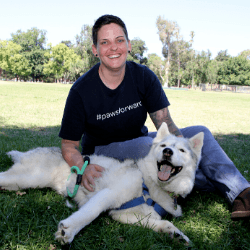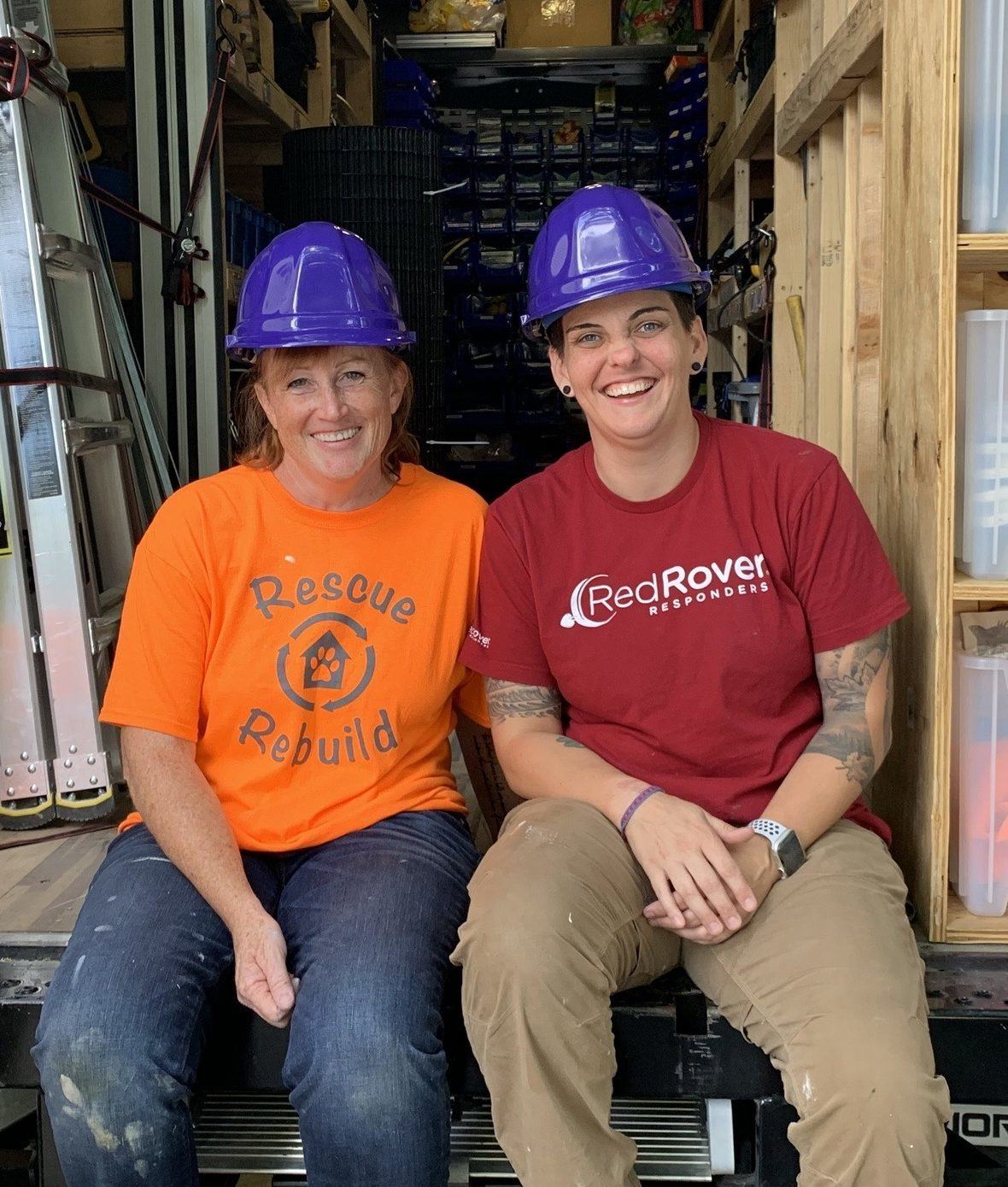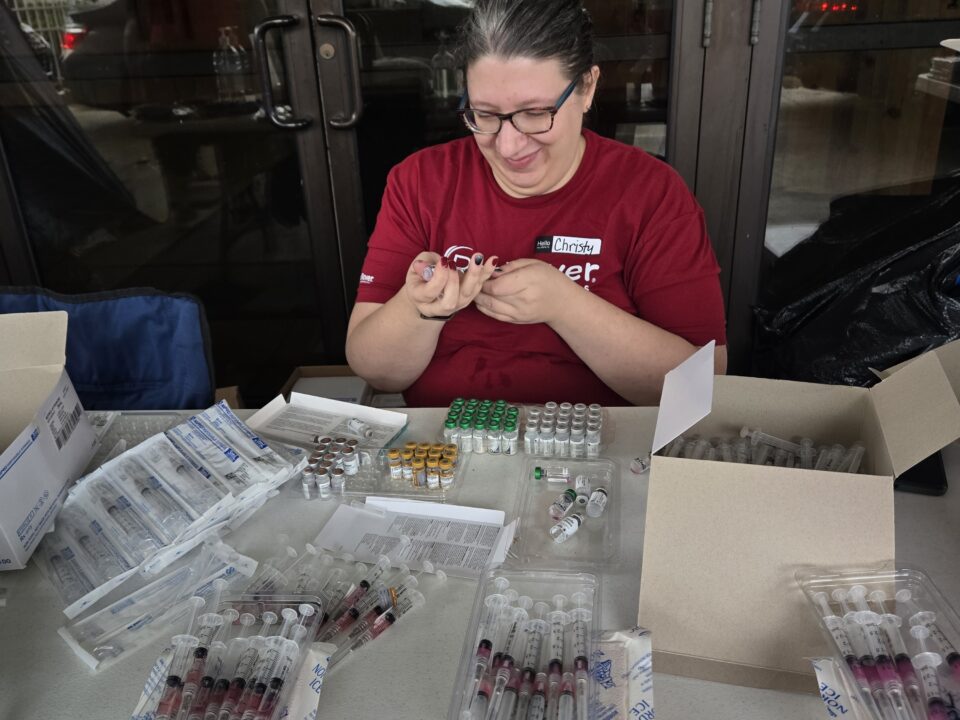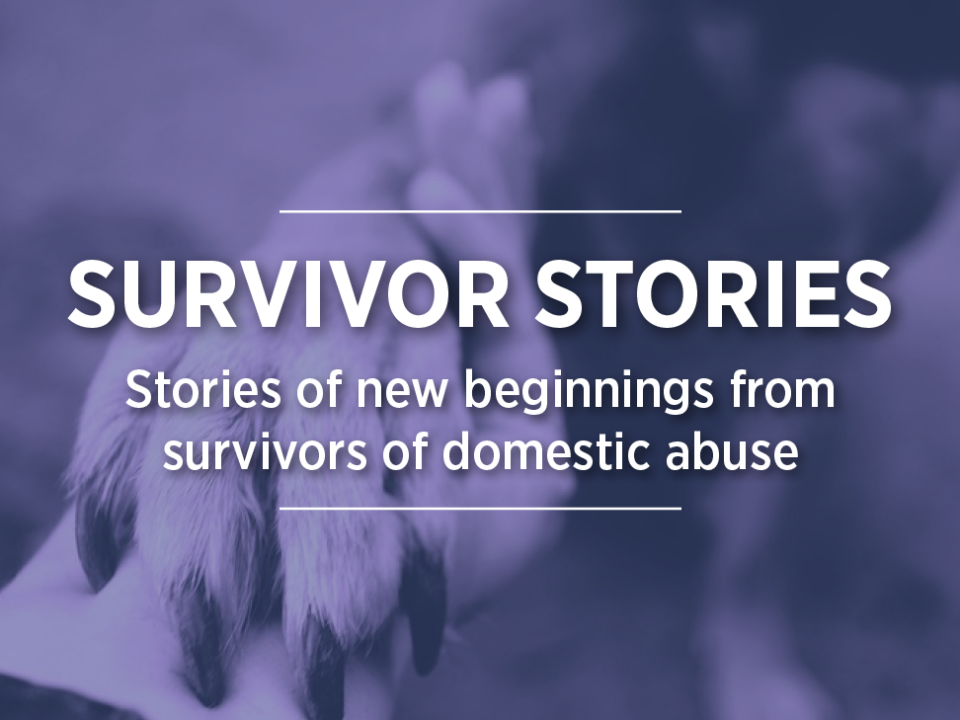Leading with Empathy: Behind the Scenes with Katie
May 14th, 2021
By Helia Zarkhosh, RedRover Communications Coordinator
What does a typical day look like for RedRover staff members? How do we answer the call for help when people have nowhere else to turn? In our new series, “Leading with Empathy: Behind the Scenes at RedRover,” we share staff stories about our efforts to bring animals from crisis to care.

Katie Campbell, Director of Collaboration and Outreach
In this feature, Director of Collaboration and Outreach Katie Campbell describes a recent visit to Safe Voices Maine, a 2019 RedRover Safe Housing grant recipient, and reflects on the importance of her work raising awareness about the link between domestic violence and pets.
Chances are you recognize Katie as one of our RedRover Responders staff. You may have met her on a deployment, or you’ve seen her big grin in photos from our builds with Rescue Rebuild. But she’s also one of our greatest public-facing champions of RedRover’s domestic violence programs, between co-hosting the Don’t Forget the Pets webinars with Rescue Rebuild, conducting extensive outreach with shelters to help them become pet-friendly, and participating in countless speaking engagements to raise awareness about the link between domestic violence and animal abuse. Once Katie starts describing her work, it only takes a moment to recognize not only her breadth of knowledge on the topic, but her heartfelt passion for the cause.
Recently, Katie connected with someone directly impacted by the work she does for domestic violence survivors and pets. It’s not often our staff has the opportunity to speak personally with a domestic violence survivor about their experience escaping abuse and finding safety. For one, applications for our Safe Escape grants, which provide funding to safely board pets of domestic violence survivors fleeing abuse, are completed by an advocate at the domestic violence shelter where the survivor has secured safe housing for themselves, not the survivor themselves. We also know that many survivors are fearful of sharing their story, especially while they’re in shelter, not only for safety and privacy reasons, but because of the stigma they face as well.

Katie with Rescue Rebuild during a recent visit to Safe Voices Maine
Katie recalls that she hasn’t interviewed a survivor for at least six years. She says, “I know that survivors of domestic abuse experience a lot of judgment just around the violence alone. When you add a pet to the mix and that someone doesn’t want to leave an abusive partner because they can’t take their pet with them, it heaps judgment upon judgment, and they’re less likely to share because of that.”
So when she asked Safe Voices Maine ahead of her scheduled visit last month if they knew of a survivor who would be willing to be interviewed about their experience, she was surprised to get a “yes.” Here, Katie reflects on her connection with a survivor named Emma* and her dog Jameson, and what she’s learned in her work to raise awareness about domestic violence and pets.
*Names changed to protect privacy.
“I think there’s a really unique and powerful connection that happens over a pet.”
“I was really struck by how freely Emma described her experience — and I think her comfort level was due, at least in part, to Jameson’s presence. I think there’s a really unique and powerful connection that happens over a pet. In that particular moment, she was just hanging out there with her dog, and the way that everyone responded to her dog, doing what we always do in gushing over an animal, allowed the conversation to flow organically as we started by talking about her dog. Think about your own experience when you’re out with your dog…if someone comes up to your dog and is super engaged and excited about your dog, it kind of opens you up to that interaction with the other person. I think that probably played a big role in it and we, of course, told her we’d protect her privacy and that helps to set up someone being able and willing to talk.”
Katie explained to Emma RedRover’s efforts to remove barriers for survivors, knowing that many feel shame or are scared to share the fact that they delay or hesitate leaving an abusive situation because of their pet. But it can provide assurance and comfort to know that others have taken that step to leave an abusive partner and take their pet with them.
With that, Emma lit up a bit. She told Katie, “I don’t want people to go through the fear that I had, and I want people to know that there is help out there and there are others in your shoes.”
Emma’s story focused on Jameson. She didn’t describe her own experience of abuse. She didn’t detail what she endured before finding safety. She explained her determination to get out – but only if she could take her beloved Jameson with her.
Emma shared her amazement that she could even bring her dog into shelter with her. And when she needed help after, it was readily available. She told Katie, “Safe Voices gives me all the help that I need. If we need vet care, we’ll get vet care.” And when Emma had a health scare and thought she may need to stay at a hospital, Safe Voices assured her they’d make arrangements for Jameson to stay in a foster home until Emma recovered. “The amount of support that has come back to me has been ten-fold. I was afraid to go into shelter; it was a huge barrier, and then once I got in and needed more support, they’ve given me everything I need.”
Raising awareness and closing the knowledge/resource gap

Katie with Bryna Donnelly of Rescue Rebuild
Much of Katie’s role involves educating domestic violence shelter staff about this issue through her various trainings and webinars. We know from research that 48-50% of survivors will delay leaving an abusive situation if they can’t take their pet with them. Katie points out that “that’s just the number for people who delay leaving; we don’t actually know how many never leave because they can’t take their pet with them.” That’s why it’s so important to not only understand and raise awareness about this issue, but to provide resources and long-term options through both domestic violence and animal shelters. Katie says:
“One of the things that I tell domestic violence shelter folks is you have to ask about pets. Prior to coming to a training, many don’t know that we have the SafePlaceForPets.org website, or that we have Safe Escape grants. From a service-delivery perspective, you don’t want to ask a survivor if they have pets if you don’t have a resource to offer.
The hope for these organizations long-term is that they’ll be able to create their own pet-friendly programs, and an important piece of that long-term plan is knowing how many survivors with pets are actually seeking their services. So it’s important to ask the question about pets. And I tell animal shelter folks the same thing: they need the same training, and it’s important for them to ask about possible domestic violence when someone shows up to relinquish a pet. I guarantee if they’re not asking that question and they have folks relinquishing pets, they’re going to unknowingly have pets of domestic violence survivors on their adoption floors.
When thinking about creating a program for pets of survivors, one barrier Katie has heard from animal shelter staff is safety:
“They’re worried that an abuser is going to show up and try and take the pet. So I point out to them that if you’re not asking about domestic violence, you already likely have those pets on your adoption floor, and you’re already opening yourself up to the safety concern. It’s critical for shelter staff to be trained in how to ask about domestic violence and respond appropriately by connecting survivors to services.”
“It wasn’t until I came to RedRover that I made the connection between domestic violence and pets.”
Katie acknowledges that the connection between domestic violence and pet abuse wasn’t obvious to her prior to her work with RedRover. Her first exposure to domestic violence was during an undergraduate internship at a domestic violence shelter in North Carolina. She later moved to Sacramento and started working at a family resource center through AmeriCorps, connecting families to resources, some of which were experiencing domestic violence.
“I grew up a pet lover. My mom was the executive director of the local humane society and we always had animals coming through, fostering them until they got adopted. But it wasn’t until I came to RedRover that I made the connection between domestic violence and that people were afraid to leave because of their pets. It just never occurred to me before then.
I think one of the most exciting things to me in this work is helping people make that connection. It’s amazing to see the moment when people realize the link and they’re like, ‘Oh my goodness, of course!’ Those same people will then say, ‘This is great, but there’s no way in the world I can welcome pets in.’ Coming from the human services world, I totally get it. I enjoy being able to work with them and help them through that process. And when they leave my webinars or trainings and tell me, ‘I’m excited. I feel like I can do this work, and I know what resources are out there,’ there’s something really amazing about that.
I like being able to break down some of those barriers that folks feel about creating these programs… It’s the same for animal shelters as well. They’re dealing with all the pets and adopting them out and then they’re like, ‘Oh, and now you want me to do human case management? There’s no way.’ But when you connect those two and you have them working together and building this community of support, it’s an amazing thing. You can create change and get people out of really scary, bad situations, and they’re going to find healing because of it.”
Removing stigma and breaking down barriers
RedRover’s programs are focused on awareness and access. Our belief that pets are family is at the core of our mission, and we know the lengths people will go for the love of their pets – including individuals who endure abuse to protect their animals. But we know that there remains a disconnect for some as to how human and animal abuse are linked. Katie reflects on why this may be:
“I think it’s the same disconnect that people experience when they don’t understand why a survivor doesn’t just leave. If they can’t understand that, then I don’t think they’re going to understand why not being able to take a pet would cause further delay. I think most folks who haven’t encountered or don’t understand domestic violence generally have a really hard time understanding why someone wouldn’t leave an abusive partner. And if they’re an animal lover, they don’t understand how the pet is used as a form of power control within that dynamic. And it doesn’t necessarily mean that the abuser is harming the pet physically. It can be that the abuser isn’t allowing the pet to get veterinary care or isn’t allowing the survivor to take the pet for walks around the block. Just as human-to-human domestic violence can look like so many different things, abuse of a pet can look like so many different things. The disconnect may also be related to the fact that these are just things we aren’t comfortable talking about.”

Katie with Seamus during a recent domestic violence build.
So Katie has made it her life’s work to bring this conversation to the forefront, to remove the stigma, and to break down barriers:
“There’s a story I like to recount from Safe Futures in Connecticut. One thing I ask organizations when they’re starting a program or thinking about starting a pet-friendly program is, ‘Why? Why are you doing this?’ And so I asked this shelter, which was the first in their state to become pet-friendly. They described an experience with a mom and her son who was about 7 or 8 when they came to stay at the shelter – and they snuck their dog in. This was in an old Victorian house, so it was amazing that they were able to sneak in their dog in the first place, but obviously it didn’t take long for shelter staff to realize there was a dog in the house. And the staff decided they weren’t going to kick this family out – they were going to make it work. They kept the family there with the dog. And something incredible happened as a result.
During all this, the little boy was really shut down. He wasn’t talking or opening up in any of his counseling sessions. But one day, they happened to hold his session in his room, where his dog was staying. The little boy goes over and sits next to his dog and starts telling his dog about all of the emotional, physical, and sexual abuse he had experienced at the hands of his abuser. He still doesn’t talk to any of the humans in the room, but he talks to the dog and discloses everything. With that information, the staff were able to connect him with the help he needed. They were able to connect with him through the dog. A couple years down the road, the family was thriving and the little boy had become so engaged and was doing so well that he became a junior volunteer for the shelter – a position they created just for him. So I always ask shelters after telling that story, ‘If that dog hadn’t been in the room on that day, would the little boy have gotten the help that he needed?’ You could certainly argue that he would have gotten the help he needed, but it wouldn’t have happened as quickly; and the family, who knows what they would have gone through, how long it would have taken them to find stability. It just goes to show you how amazing it is when all members of the family, whatever your family unit looks like, can feel safe and find healing together.It’s a powerful story to show the importance of it, but it also reminds me that even when survivors leave and they aren’t able to take their pets with them, many return out of concern for the pet. The ASPCA found that as many as 25% of survivors will return because the abuser is using that pet as a means to get the person back. It just doesn’t need to be that way. I don’t say this casually, but becoming pet-friendly isn’t that difficult.”
Changing the landscape for survivors with pets
Becoming pet-friendly looks different for every organization. What Katie hopes people take away from her presentations is that there’s no one right way to do it, but it can be done:
“It really is about what works for an individual organization, for the collaborative partnership in the community. I want folks in organizations to feel comfortable reaching out and talking to each other about these issues.”
Our goal through the Purple Leash Project, a collaborative effort between RedRover and Purina to help keep more survivors and their pets together, is for 25% of U.S. domestic violence shelters to become pet-friendly by the end of 2025. Katie’s hope? To change the landscape of services for survivors with pets:
“I want to see us at 75% someday. I want to see us continue to grow our programs. I think we’re getting to that point where accepting pets of all kinds is just normal; where talking about domestic violence is normal, and people seeking resources for it is normal.”
To learn more about our domestic violence programs and how you can be a part of the change we’re working towards, visit RedRover.org/domestic.



